Canadian Scott Bennett is a widely published photographer and writer and has visited some of the most exotic places on the planet, from the heights of the Himalayas to Indonesia’s coral reefs and the African savannah.

During an extended business trip to the Philippines, an introduction to underwater photography developed into an obsession that eventually became a career, and he now seizes every opportunity to capture the beauty of the world’s oceans. Here, in his own words, are the stories behind some of this favourite underwater images.
Bali
Boxer crab with eggs
Although I do enjoy shooting wide-angle photos, macro is undoubtedly my favourite aspect of underwater photography, and one of my preferred locations is Seraya, situated off the east coast of Bali. Although the black sand appears lifeless on the surface, looks can be deceiving – it is actually home to an amazing assortment of creatures (often called ‘critters’ by macro enthusiasts).
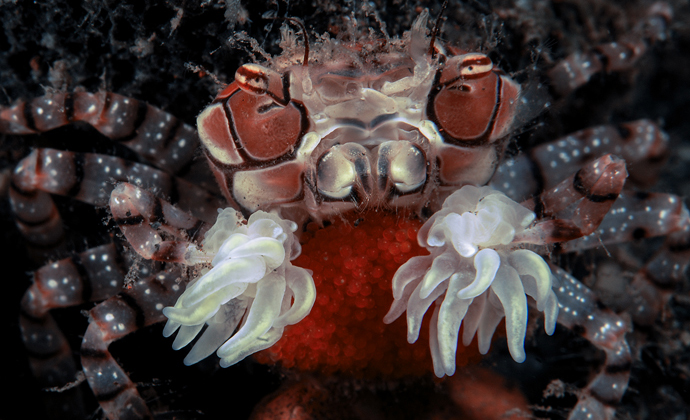
High on my wish list was the boxer crab, a miniscule crustacean barely bigger than a fingernail. Sporting tiny stinging anemones on its claws, it fends off would-be attackers like a truculent cheerleader. I discovered this specimen just offshore, protecting a jewel-like cluster of red eggs beneath its carapace.
Indonesia
Lionfish
Common lionfish are routinely encountered in the Asia Pacific region, so much so that they can be easily overlooked in favour of more exotic undersea residents. Despite their lacy appearance, the dorsal fines pack a venom capable of causing excruciating pain.
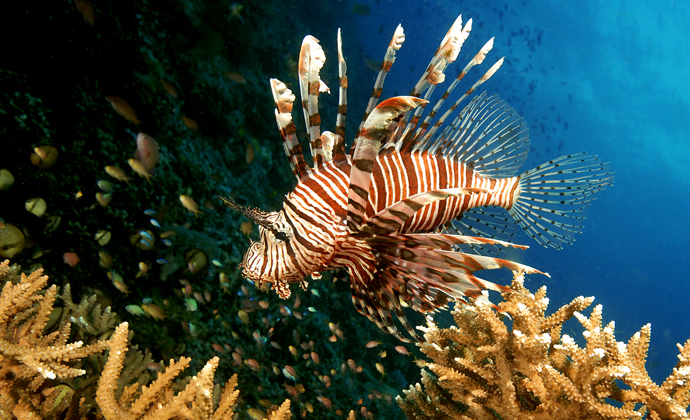
Nocturnal hunters, they spend the day ensconced in crevices, making photography virtually impossible. While diving at Moyo Island, however, I happened upon this specimen in broad daylight. Positioned just off a hard-coral wall with the blue water as its backdrop, it presented the perfect photo opportunity.
Weedy scorpionfish
I must admit that switching to digital was something I resisted for a long time, but my trepidation soon vanished when I started shooting underwater and discovered I was no longer restricted to 36 exposures.
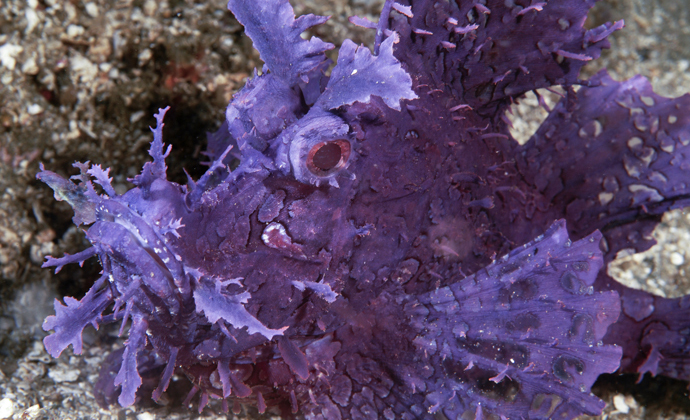
Taken in Ambon, in the Maluku islands of Indonesia, this weedy scorpionfish was one of my first images attempted with a digital camera. It is also something of a Holy Grail for underwater photographers, and the first of such specimens I had ever seen.
Papua New Guinea
Hawksbill turtle
It may be difficult and expensive to get to, but Papua New Guinea is one of the world’s premier dive locations, owing to its sheer diversity of marine life. While on a live-aboard trip off the island of New Britain, I came across this hawksbill turtle feeding on a seamount.
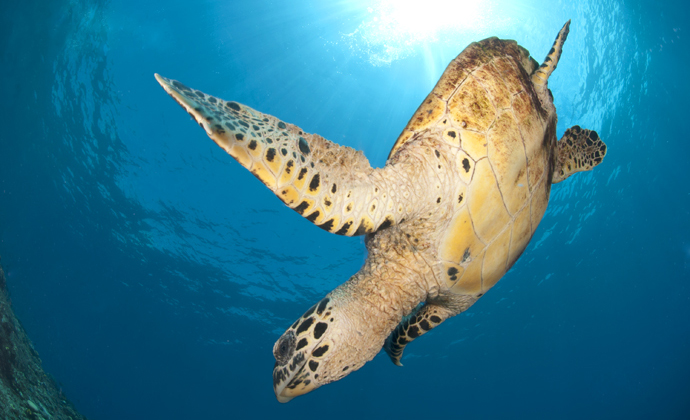
Moments later, it ascended to get some air and I quickly moved into position. As it descended to continue feeding, I snapped an image with a sunburst directly behind it. The turtle was close enough to practically be touching my domeport and I used twin strobes to illuminate its underside.
Pink anemonefish
Like other clownfish species, pink anemonefish can be very camera shy, but when an anemone has just digested a meal, the majority of the stinging polyps are withdrawn into the body, and the resident anemonefish have nowhere to hide.
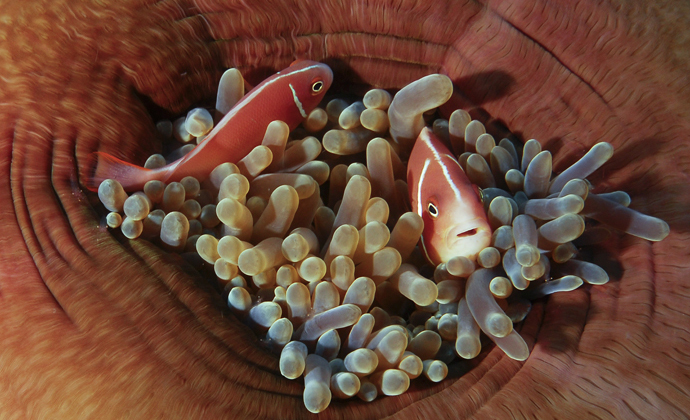
Essentially trapped, this pair defiantly held their position and I was able to snap a few shots, before moving on to leave them in peace.
Fiji
Carpet Reef
I had come to Fiji’s Beqa Lagoon for the exceptional shark diving, but the coral reefs made an equally strong impression. Fiji is especially famous for soft corals and Carpet Reef didn’t disappoint. By dive’s end, I had broken my all-time photographic record – 130 images in total. At times like this, I definitely don’t miss the days of film!
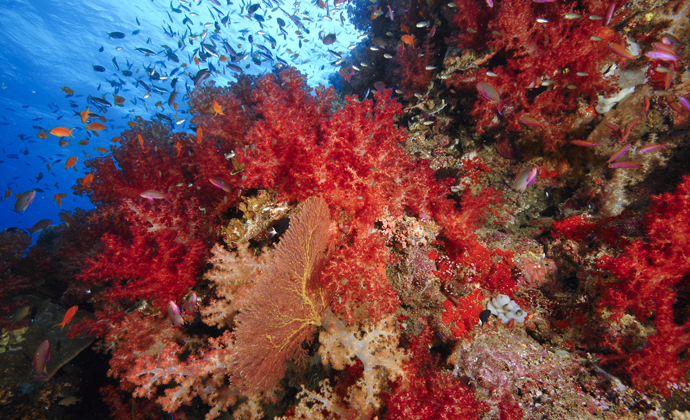
This is wide-angle territory, with clear visibility and minimal currents that made for ideal photographic conditions. The blue water above provided a nice contrast to the blaze of reds, while swarms of reef fish and a solitary fan coral completed the picture.
New Zealand
Northern scorpionfish
Situated 23km off New Zealand’s North Island are the Poor Knights Islands, a place Jacques Cousteau rated as one of the world’s top-ten dive locations. Precipitous cliffs plunge below sea level, creating an aquatic wonderland of caverns, sea caves and arches where subtropical endemics mingle with tropical exotics. Approximately 60 dive sites are found throughout the islands, playing host to over 125 fish species.
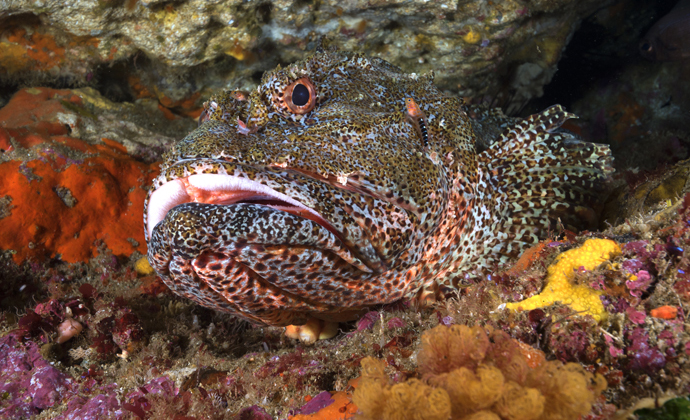
Northern scorpionfish quickly became a photographic favourite. Larger than their tropical relatives but lacking their venomous punch, they proved both abundant and tolerant. One hefty specimen was especially obliging, allowing for frame-filling portraits. While reviewing the images, I was surprised to find a pair of tiny hitchhikers on its head, a pair of blue-dot triplefins that I didn’t even spot on location.
HMS Canterbury
During a trip to the Bay of Islands, I had the opportunity to photograph one of New Zealand’s premier wrecks – the HMS Canterbury. Located in Deep Water Cove off the Cape Brett Peninsula, the 113m-long vessel was one of two broad-beam Leander-class frigates operated by New Zealand’s Royal Navy from 1971 to 2005.
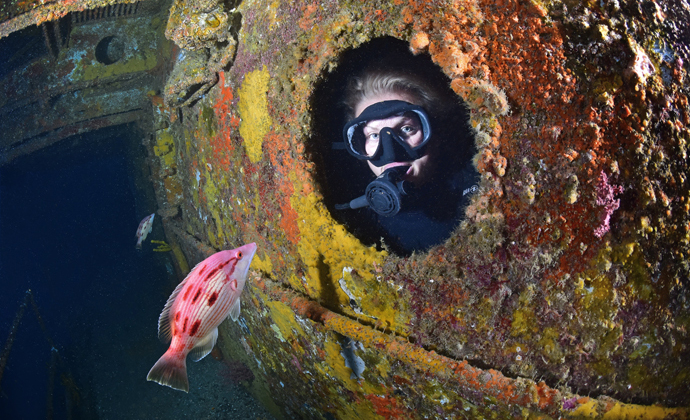
After 35 years of service, the vessel was decommissioned in 2005 and sunk on 3 November 2007 to create an artificial reef. Fortunately, my dive on the Canterbury provided exceptional visibility and I was able to capture this clear shot of my dive buddy, Faye Stimpson, framed by a porthole. Right on cue, a red pigfish swam into frame to complete the image.
Palau
Golden jellyfish
I first visited Palau just after I started doing underwater photography back in 2002. The diving was superb, and one location left me utterly spellbound: Jellyfish Lake. One of 70 marine lakes in Palau, it is home to a unique population of jellyfish that, isolated for thousands of years, gradually lost their ability to sting.
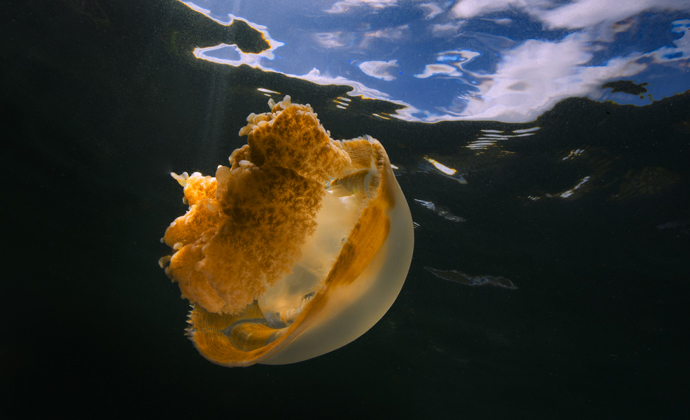
I envisioned a shot with a jellyfish silhouetted against the sky, but my woeful free-diving skills nixed that idea. Thankfully, I then had an epiphany: I positioned my camera beaneath one specimen and shot upwards. After some trial and error, I got this image.
Mexico
Great white shark
The mere mention of sharks is enough to make most people recoil and the great white undoubtedly invokes the greatest fear response of all. The undisputed bad boys of the shark world, great whites are the largest of all predatory sharks, reaching lengths of up to 6m and weighing in at over 2,000kg. Yet, these beautiful creatures must be among the most misunderstood creatures in the ocean.
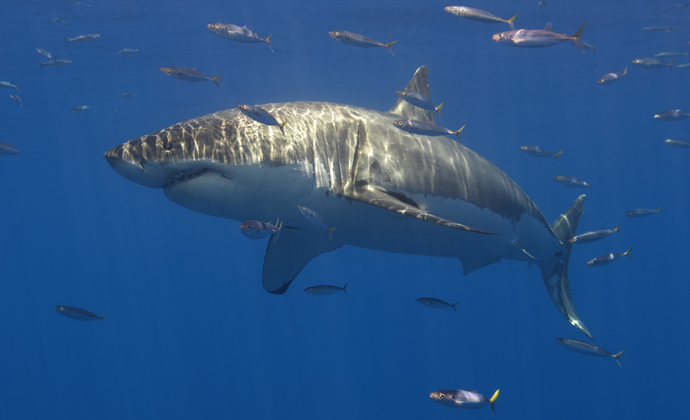
Set in the Pacific Ocean 240km off Mexico’s Baja California peninsula, Guadalupe is one of the world’s premier locations for observing great whites. Diving isn’t allowed (for obvious reasons!), but trip participants view the sharks from cages secured to the stern of the boat. The offshore location provides crystal-clear visibility and the sharks are numerous, allowing for astonishing close-up encounters.
Honduras
Juvenile spotted drum
The island of Utila is one of the undisputed jewels of the Caribbean, possessing beautiful reefs and abundant sea life. However, one particular species was high on my photographic wish list. Boasting an elegant dorsal fin and black and white colouration, the juvenile form of the spotted drum is especially striking.
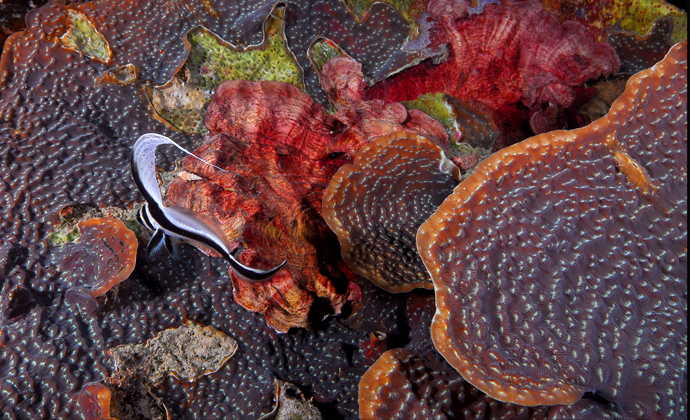
On one dive, I spotted a specimen swimming in an endless loop above a vivid tableau of plate corals. Initially skittish, it quickly became relaxed in my presence and I managed to shoot a number of exposures, but this one specifically captured the composition I was after.
Philippines
Mantis shrimp
Situated across the Mindoro Strait from Puerto Galera in the Philippines, Anilao is a world-renowned location for macro photography, especially as new species are being discovered here all the time. One of its most notorious residents is the mantis shrimp.
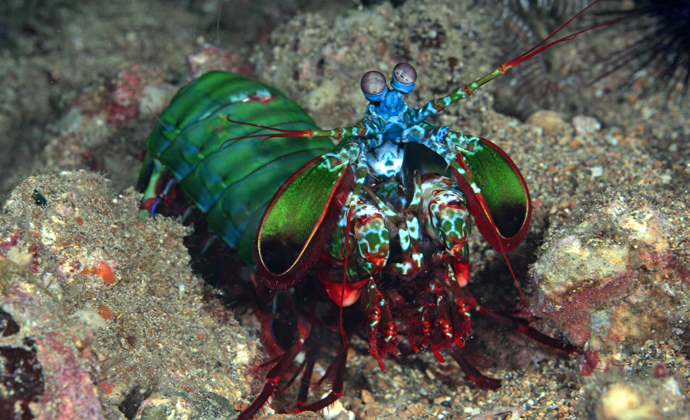
This specimen is known as a ‘smasher’, as its powerful claws are able to punch with the force of a bullet and it is unusual to see them out of their burrows for long periods of time, especially during the day. Not surprisingly, I didn’t want to get to close, especially as this individual was clasping a clutch of eggs.
Yellow gobies
Anilao’s sites may not win any awards for beauty, but everything merits closer scrutiny, even the rubbish strewn on the ocean floor. I had just noticed an old bottle partially buried in the sand when a flash of yellow caught my attention.
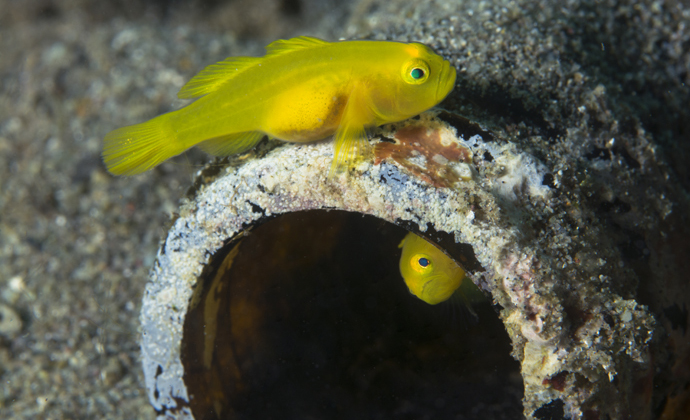
Patience was essential for capturing this image of two tiny yellow gobies, which grew skittish every time I tried to approach. I took many images but only one captured the perfect shot of the second fish peering out.
Juvenile frogfish
Frogfish have always been one of my favourite photographic subjects. Coming in all manner of sizes and colours, they rarely swim, preferring to hop along the sea bottom using their pectoral and pelvic fins. Being ambush hunters, they remain perfectly immobile, waiting for their prey to come within striking range, but nevertheless, they can be surprisingly hard to spot.
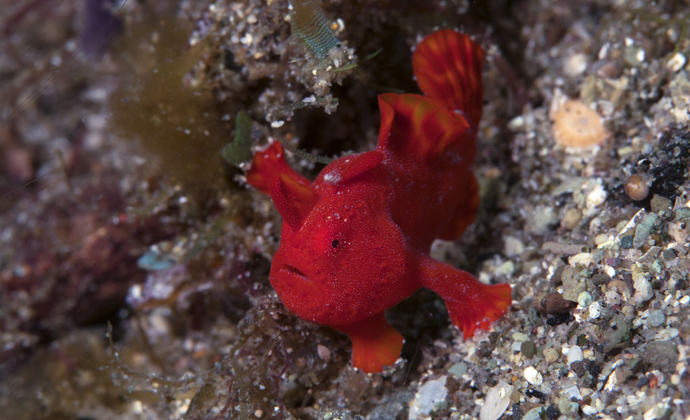
I encountered this individual on a seemingly barren expanse of sand in Anilao. No bigger than a fingernail, it was the smallest frogfish I had ever seen and even with a close-up filter and macro lens, I struggled to focus on it. True to form, however, it remained perfectly still, and I finally captured this image.
St Helena
Whale shark
Reaching lengths of up to 18m, whale sharks are the biggest fish in the sea. Despite their immense size, these are filter feeders, sieving plankton and small fish through mouths up to 1.5m wide. They can be notoriously camera shy, especially when besieged by curious onlookers. Fortunately, this wasn’t the case in St Helena. Situated in the South Atlantic between Africa and South America, the island is one of the most remote destinations I have ever visited.
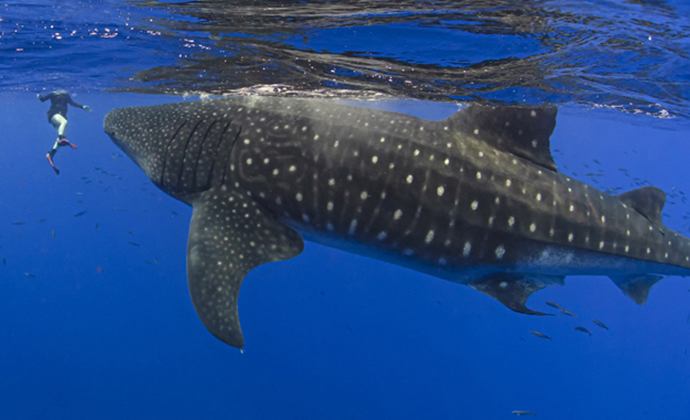
My arrival in February coincided with whale shark season and I couldn’t wait for the opportunity of a close-up encounter. Although snorkellers must maintain a distance of 3m, I quickly discovered the sharks are unaware of the rules. On our second excursion, a massive 10m specimen cruised in for a closer look. This individual was especially inquisitive, approaching a snorkeller so closely she had to vigorously fin backwards to avoid a collision. For more on Scott’s experiences in St Helena, click here.
Grenada
Veronica L wreck
I was once told that ‘if you have dived the Pacific, don’t bother with the Caribbean’. Anchored at the southern end of the Grenadines in the southern Caribbean, the island of Grenada utterly negates this statement. In addition to the pristine reefs and abundant marine life, it is renowned for being the wreck-diving capital of the Caribbean.
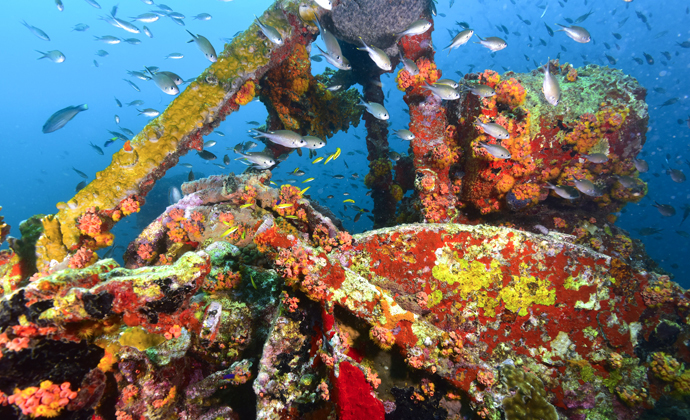
One of my favourite sites was the Veronica L, a small cargo vessel so encrusted with growth it bore the appearance of a ship sculpted from sponges. Situated in less than 12m of water, the deck was strewn with machinery, including a crane with a 6m-long arm, providing a haven for swarms of fish.
The port side revealed dense congregations of cup corals as fireworms skittered about. Shooting upwards in the shallow water ensured a blue backdrop to the teeming fish life and vibrant growth. Best of all, the shallow depth ensured a long dive, providing endless photo opportunities. Underwater photography doesn’t get any better than this.
Malaysia
Mandarinfish
Boasting a wardrobe bordering on the psychedelic, the mandarinfish is one of the reef’s most beautiful residents. Native to the western Pacific, mandarinfish are legendary for their mating habits, attracting divers from far and wide to observe their nightly liaisons. Sequestered among coral and rubble during the day, they appear only at dusk to mate. However, obtaining a successful photo requires a good measure of luck.
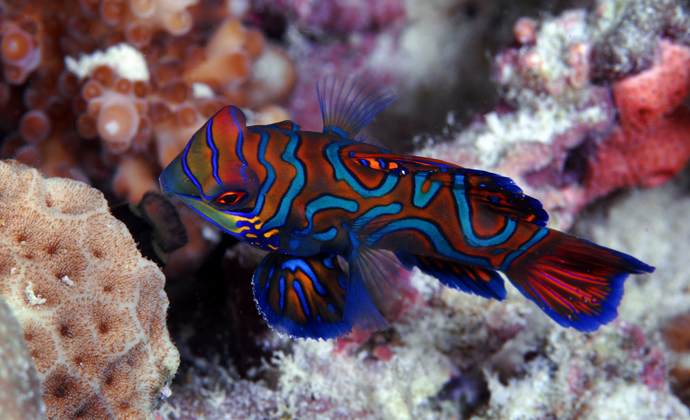
I was on the island of Mabul, located just off the east coast of Sabah in Malaysian Borneo, to witness a mandarinfish mating spectacle. As the fish are agitated by light, my dive guide applied a red gel over the end of his torch, creating an infrared effect that didn’t disturb them. A number of fish soon appeared, but focusing on tiny, moving subjects via torchlight proved extremely difficult. This individual emerged from behind some coral, however, and I managed to snap a few images before it promptly retreated.